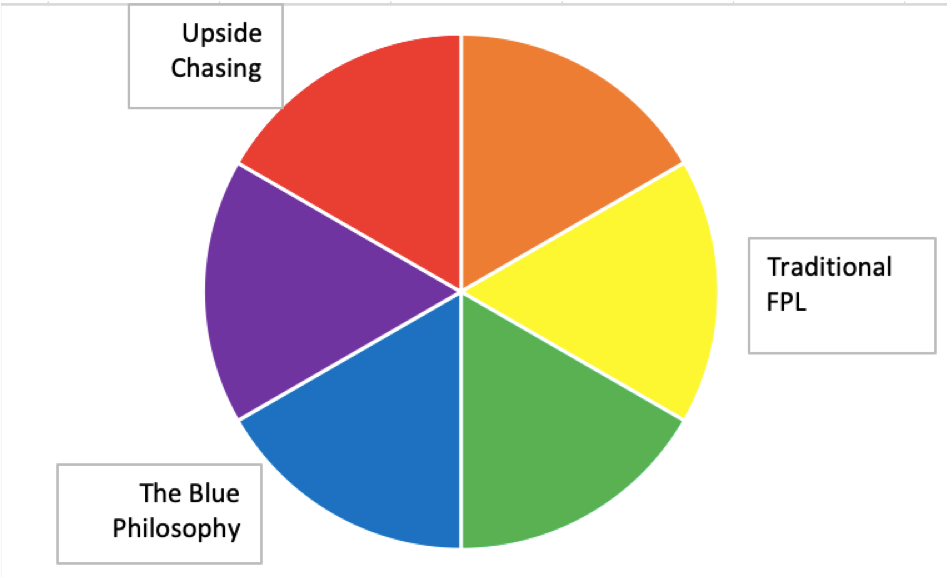This article is dedicated to trying to show that it is possible and reasonable to adopt elements of the two major challenges to traditional FPL theory, Upside Chasing (which I labelled “Red”) and the Blue Philosophy, and combine them into a coherent philosophy of how to play FPL. I feel like sometimes I appear to others to go back and forth between advocating aggressive and very patient approaches, with the only consistency being disdain for fear-based adherence to the template. While it’s important to adjust strategy from season to season based on the conditions, I’d like to show that there is a consistent approach behind being a Purple manager. Besides being a huge Magnus Carlsen fan.

Red and Blue Parts of a Team
In his article on Upside Chasing, Lateriser very nicely developed a concept of “glue guys”, players that are not necessary to switch around frequently and can easily remain part of a team until the next wildcard, if not for the whole season. In the context of my FPL Colour Wheel, it is possible to think of a team as having “Blue” parts (the glue guys) and “Red” parts (the players who are frequently shifted around). A manager who is fundamentally Red can then still have a Blue part of the team, usually consisting of the goalkeeper, defenders, and maybe one or two consistent midfielders or forwards. The manager aims to set and forget this part of the team, barring injuries or multiple-game suspensions. The premium assets then become the Red part of the team, which are the focus for making high-value transfers. With some adjustments, even a Yellow team can be conceptualised in this way; however, Traditional FPL would tend to make the premium attackers Blue (set-and-forget), while budget attackers would be Red (subject to frequent transfers), rather than the reverse. Meanwhile, a devoted Blue manager might try to make most of the team Blue, with only a few patches of Red. An Orange manager might make only the defenders and goalkeeper Blue, with all attackers being Red.
As a Purple manager, I adjust the emphasis placed on Upside Chasing vs patient management based on the observed conditions. If I observe other managers playing successful wildcards and taking successful hits, I adjust my strategy more toward the Red end of the spectrum. Conversely, if I observe other managers playing unsuccessful wildcards and taking unsuccessful hits, as I observed at the start of the 2020-21 season, I adjust my strategy more toward the Blue end of the spectrum. Unlike many managers who take hits when their rank is poor and avoid them when their rank is good, I try not to base my strategy too much on my own rank. If we are in an environment where hits are not working, I try hard to remain patient even if my rank is poor. If we are in an environment where hits are paying off, I try to be more aggressive even if my rank is good. That said, we only need to look at Magnus’s style to see that there are other ways to be aggressive besides taking lots of hits.
Must a Purple Manager Oppose Everything Tried and True?
Purple is often a lonely place to be for an FPL manager. If you’re like me, you’ll agree with many of the most conservative managers in terms of things like avoiding hits, not booking in transfers shortly after a wildcard, and not playing the first wildcard before you have a good sense of the landscape. At the same time, you’ll scoff at some of them for their reverence toward the template and their self-description as very risk-averse managers. You’ll also largely oppose the typical Orange manager’s obsession with team value. At the same time, you don’t have to be overly ideological; you can borrow ideas from managers quite unlike yourself. For example, I agree with Joe Lepper on the usefulness of price points, and with Mark Sutherns on using a strong bench to remain resilient in times of crisis. I also find myself agreeing with certain Yellow managers at times on the hazards of planning out too many transfers in advance, at the cost of not being poised to react to changing circumstances. I’m even prone to shake my head at Yellow managers for often not capitalising on their own greatest strengths, sometimes being too influenced by Red doctrines that a single transfer of a budget attacker is wasteful. Ideally, if you embrace being a Purple manager, you’ll gain a reputation for two qualities that are both prized in the FPL community: patience and fearlessness.
At times I’ve thought I’m not doing enough upside chasing to really qualify as Purple, so I’m leaning more toward the Blue side. However, I think one idea where I really disagree with many managers toward the Blue and Green side is with the approach to the first wildcard. Like many others, I find the first mini-season as something to survive, starting with a near-maximally flexible structure in light of the very limited information we have to start the season. However, many managers are still keen to stay very flexible into the second mini-season, especially given its length. I’m more prepared to attack the second mini-season with the best team I can produce, even at the cost of flexibility. The Blue part of the team is valuable as an area I won’t have to waste transfers on, barring injuries, and my bench helps protect against injuries breaking my team.
By around the second international break, we have enough information that a significant change of structure may be beneficial. We know which price points are strong and which are almost barren, and we should be able to confidently omit the latter from our structure – not that we’ll never, ever, ever get them in, but we’re happy to spend two transfers later on to be able to attack more with our ideal team. I wonder sometimes if managers are reacting to the failures of too-early wildcarders and assuming that a wildcard around Gameweek 8 could flop just as hard. If we clean out deadwood and install appropriate glue guys, armed with plenty of information, we shouldn’t have much to worry about. This doesn’t mean an extremely punty wildcard full of soon-to-be deadwood just brought in, but it can mean more confidence that a structure that looks good for the present will remain good. In fact, we’ll commit to the structure and shake our heads at template managers who “chase last week’s formation” after a gameweek where random variance strongly favoured either defenders, midfielders, or forwards. With a full understanding of how the three mini-seasons differ, we can perceive how a team with a flexibility rating of around 8 rather than 10 is slightly risky in Gameweek 1, but might even be overly conservative as a first wildcard team.
Even if I’m maybe not that into upside chasing at some level, I still feel a natural affinity with Red managers in siding with Lateriser against Orange and Yellow managers on a wide variety of issues. The whole idea of setting up a team so that you can make luxury transfers is very appealing to me, whereas for some it’s a burden to have a transfer that doesn’t obviously need to be used in a specific way. In stark contrast to Lateriser, some actually use the term “luxury transfer” with a negative connotation. The Purple manager’s opposition to restructuring the team outside of wildcards imbues the first wildcard with a clear purpose, since it’s the only opportunity to make major structural changes in the first half of the season. I’ve never been worried about wasting a wildcard. If it fails, it was still used for a purpose more significant than simply cleaning up a mess.
Conclusion
There are more reasons to identify as Purple than simply being a Magnus Carlsen fanboy. Actually, there are many things Magnus does that I don’t feel that competent to emulate, so I don’t try. However, the general combination of avoiding wasted transfers to enable pursuing the best transfers is Purple management at its best.





2 years, 5 months agoCheers for writing MLS, really interesting read as always!